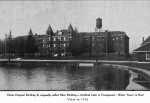Difference between revisions of "Portal:Featured Article Of The Week"
M-Explorer (talk | contribs) |
M-Explorer (talk | contribs) |
||
| Line 1: | Line 1: | ||
{{FAformat | {{FAformat | ||
| − | |Title= | + | |Title= Eloise Asylum |
| − | |Image= | + | |Image= Eloise13.png |
|Width= 150px | |Width= 150px | ||
| − | |Body= | + | |Body= In 1839, only two years after Michigan had joined the Union, Wayne County paid $800 to buy a 160-acre farm in Nankin Township (now Westland). The purchase included a log cabin known as the Black Horse Tavern. The County erected an addition to the tavern building and used it to house 35 needy people, a keeper and his wife. They called it the Wayne County Poorhouse. Its first residents were transferred from another poorhouse at Gratiot and Mt. Elliott in Detroit . Many refused to move, claiming the new poorhouse was "too far out in the wilderness." And they were right -- at that time the corner of Michigan and Merriman was nearly two days by stage coach from Detroit. |
| − | + | But that was what the county officials had in mind. They wanted somewhere well out of sight to send what they saw as society's dregs -- the vagrants, vagabonds, drunkards, pilferers and brawlers. With such a broad charter, it wasn't long before the feeble-minded and the insane were being housed there. Records show that a Biddy Hughes was Eloise's first official mental patient, committed by her family in 1841. She was in her mid-30s when admitted and was kept there until her death 58 years later. | |
| − | + | Prior to the 1840s, little distinction was made between rational and mentally ill inmates. A county report from the 1840s made reference to harsh restraints used to separate the mentally ill from other inmates. The mentally ill were housed on the upper floor of a farm building used to keep pigs. | |
| − | The | + | County employee Stanislas M. Keenan reported in his 1913 book, "The History of Eloise," that in the first few years people in the surrounding area heard "the chained unfortunates roaring and shrieking in discord with the squealing pigs beneath." Conditions improved in 1869 when the mentally ill were moved to a new building where they were supervised by a neighboring farmer and his wife. But the chains remained until 1881, when Dr. E.O. Bennett, Eloise's first medical superintendent, did away with them. [[Eloise Asylum|Click here for more...]] |
}} | }} | ||
Revision as of 03:43, 12 August 2013
Featured Article Of The Week
Eloise Asylum
In 1839, only two years after Michigan had joined the Union, Wayne County paid $800 to buy a 160-acre farm in Nankin Township (now Westland). The purchase included a log cabin known as the Black Horse Tavern. The County erected an addition to the tavern building and used it to house 35 needy people, a keeper and his wife. They called it the Wayne County Poorhouse. Its first residents were transferred from another poorhouse at Gratiot and Mt. Elliott in Detroit . Many refused to move, claiming the new poorhouse was "too far out in the wilderness." And they were right -- at that time the corner of Michigan and Merriman was nearly two days by stage coach from Detroit.
But that was what the county officials had in mind. They wanted somewhere well out of sight to send what they saw as society's dregs -- the vagrants, vagabonds, drunkards, pilferers and brawlers. With such a broad charter, it wasn't long before the feeble-minded and the insane were being housed there. Records show that a Biddy Hughes was Eloise's first official mental patient, committed by her family in 1841. She was in her mid-30s when admitted and was kept there until her death 58 years later.
Prior to the 1840s, little distinction was made between rational and mentally ill inmates. A county report from the 1840s made reference to harsh restraints used to separate the mentally ill from other inmates. The mentally ill were housed on the upper floor of a farm building used to keep pigs.
County employee Stanislas M. Keenan reported in his 1913 book, "The History of Eloise," that in the first few years people in the surrounding area heard "the chained unfortunates roaring and shrieking in discord with the squealing pigs beneath." Conditions improved in 1869 when the mentally ill were moved to a new building where they were supervised by a neighboring farmer and his wife. But the chains remained until 1881, when Dr. E.O. Bennett, Eloise's first medical superintendent, did away with them. Click here for more...
